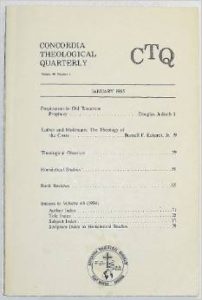 In the January 1977 (volume 41, number 1) issue of Concordia Theological Quarterly, a five-page article by David P. Scaer was published titled: The Problems of Inerrancy and Historicity in Connection with Genesis 1-3. (Click on the link at the bottom of this post to read the article for yourself.)
In the January 1977 (volume 41, number 1) issue of Concordia Theological Quarterly, a five-page article by David P. Scaer was published titled: The Problems of Inerrancy and Historicity in Connection with Genesis 1-3. (Click on the link at the bottom of this post to read the article for yourself.)
Based on the title you might expect the article to be either an apologetic for Genesis 1-3, showing how verifiable and empirical facts can be understood in a framework that accepts Genesis 1-3 as historical, or an article that argues that, because Genesis 1-3 does not conform to contemporary secular scientific theories, these chapters need to be understood in some symbolic fashion. However, Scaer does neither of these things.
 In general there are two different approaches to Genesis 1-3 taken by people who wish to maintain that the Bible is the inspired word of God. Group One views the chapters as history. Scaer ignores this group. Group Two tends to treat Genesis 1-3 as somehow symbolic. It is either allegory, or parabolic, or myth, or something else. They then seek to understand the underlying truth or message in the chapters. In taking this approach Group Two can maintain that they believe in the Bible while also believing in contemporary scientific theories.
In general there are two different approaches to Genesis 1-3 taken by people who wish to maintain that the Bible is the inspired word of God. Group One views the chapters as history. Scaer ignores this group. Group Two tends to treat Genesis 1-3 as somehow symbolic. It is either allegory, or parabolic, or myth, or something else. They then seek to understand the underlying truth or message in the chapters. In taking this approach Group Two can maintain that they believe in the Bible while also believing in contemporary scientific theories.
Perhaps Group Two takes this approach so they can find a way to witness to non-Christians who hold to the same scientific theories. Perhaps they simply do not want to bear the burden of ridicule. Perhaps they haven’t thought deeply about the various options “out there” and are simply being carried along in the cultural currents. Perhaps there are other reasons one might seek to straddle the fence on this topic.
It is Group Two that will find this article most interesting and challenging. Scaer is asking if the symbolic/allegorical/parabolic/etc. approach actually works. What would it mean to take words like “day” and “serpent” in some symbolic fashion? Is there any biblical (as opposed to scientific) reason to do so?
The article is well written and quite interesting. The only “problem” with the article is that I felt it ended too quickly. You, therefore, have to extrapolate to other questions that are not covered. Still, that extrapolation should not be too difficult. I can recommend the article.
The Problems of Inerrancy and Historicity
Blessings in Christ,
Pastor
